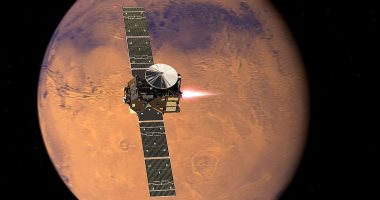Scientists know that Mars has been volcanically active for a long time, but a recent study showed that there may be magma flowing deep inside Mars even today, erupting from a volcano for the past fifty thousand years, according to RT.
A team of international scientists, led by the ETH Zurich, analyzed a group of more than 20 recent earthquakes, some of which may have been caused by a hot source that can only be explained by current magma.
With this in mind, the team examined satellite images of the area and found dark deposits of dust more than 18 feet below the surface indicating a volcanic region.
This discovery, if confirmed, would rewrite the history of the Red Planet, indicating that volcanic activity did not exist at least four billion years ago.
“The darker shadow of the dust provides geological evidence of recent volcanic activity – possibly in the last 50,000 years – which is relatively young, geologically speaking,” Simon Stahler, lead author of the paper, said in a statement.
The team was studying earthquakes at Cerberus Fossae, a series of near-parallel fissures on Mars that are formed by crustal breakage faults, using NASA’s InSight rover, which arrived on the Red Planet in November 2018.
Its mission is to reveal how the rocky body formed and evolved on a planet by investigating the internal structure and composition of Mars. It also determines the rate of Martian tectonic activity and the effects of meteorites.
Previous research has suggested that Cerberus Fossae has been volcanically active for the past 10 million years, but the new discovery could rewrite the timeline.
According to Stahler: “It is possible that what we are seeing is the last remnant of this active volcanic region or that the magma is now moving east towards the site of the next eruption.”
The study, published in the journal Nature, notes that scientists now believe Cerberus Fossae represents a unique tectonic environment shaped by current magma processes and locally elevated heat flux.
“While there is a lot to learn, the evidence of possible magma on Mars is intriguing,” says Anna Mittelholz, a postdoctoral fellow at the Federal Institute of Technology in Zurich and Harvard University.
The groundbreaking discovery comes just months after the Australian National University suggested the earthquakes are caused by a sea of magma in the Red Planet’s mantle.
Hundreds of Martian earthquakes have been detected so far, but Hrvoje Tkalić of the Australian National University and fellow geophysicist Wijia Sun of the Chinese Academy of Sciences wanted to look for earthquakes that may have gone unnoticed in the InSight data.
Using two recently applied unconventional techniques, the duo discovered 47 new seismic events originating from the Cerberus Fossae region.
Most of them resemble the waveforms of two Cerberus Fossae earthquakes, which occurred in May and July 2019, suggesting that smaller earthquakes are related to larger ones.
While researching the cause of the earthquakes, the team found that there was no pattern in their timing, which rules out the influence of the Martian moon Phobos.
“We found that these earthquakes on Mars have occurred repeatedly at every moment of the Martian day, while earthquakes on Mars, which have been detected by NASA and reported in the past, appear to have only occurred during the night, when the planet is at its quietest. “, Tkalić said.
Therefore, we can hypothesize that the movement of molten rock in the mantle of Mars is the engine of these 47 recently discovered earthquakes under the Cerberus Fossae region.


